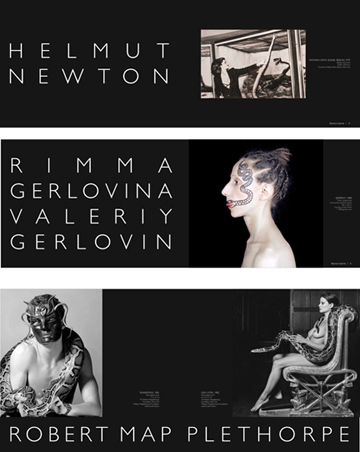RIMMA GERLOVINA and VALERIY GERLOVIN, SERPENT © 1989, C-print
BIBLIOGRAPHY
Exhibition SerpentiForm at Singapore Art Science Museum : Aug 19 - Oct 15, 2017 and Mori Art Museum, Tokyo: Nov 25 - Dec 25, 2017, organized by Bulgari, pages from the catalog (photography part):
Exhibition SerpentiForm at Museo di Roma in Rome, Italy, and book Serpenti in Art, text by Anthony Downey, (Bulgari, Roma and Canvas Central, Dubai, 2016), pp.96-101. Participating artists: Paul Gauguin, Toulouse-Lautrec, Alphonse Mucha, Gustav Klimt, Henry Rousseau, Alexander Calder, Niki de Saint Phalle, Sigmar Polke, Jean-Michel Basquiat, Adam Fuss, Mike Kelley, Marina Abramovich, Robert Mapplethorpe, and others.
"We regard art as an organic union of interrelated parts whose balance, as in any living organism, is important to maintain.Ó
Éthe New York-based couple are also inspired by mythology and philosophy, and have published extensively on a range of related subjects. Their aim is to shift the focus from the conceptualisation of an object to the conceptualisation of the subject, often using very basic media to create their images. They also use their own bodies as vehicles for their work, further compressing meaning in a practice that embraces paradox and playfulness.
In Gerlovina and GerlovinŐs Serpent (1989) this shape shifting is literalised as the female becomes one with the snake, down to the ÔforkedŐ tongue that they both apparently share. The relationship of women to snakes has been used by a significant number of female artists to promote a more empowered image of femininity and to dispel the negative connotations of women and their association with serpents. Text by Anthony Downey, p.96
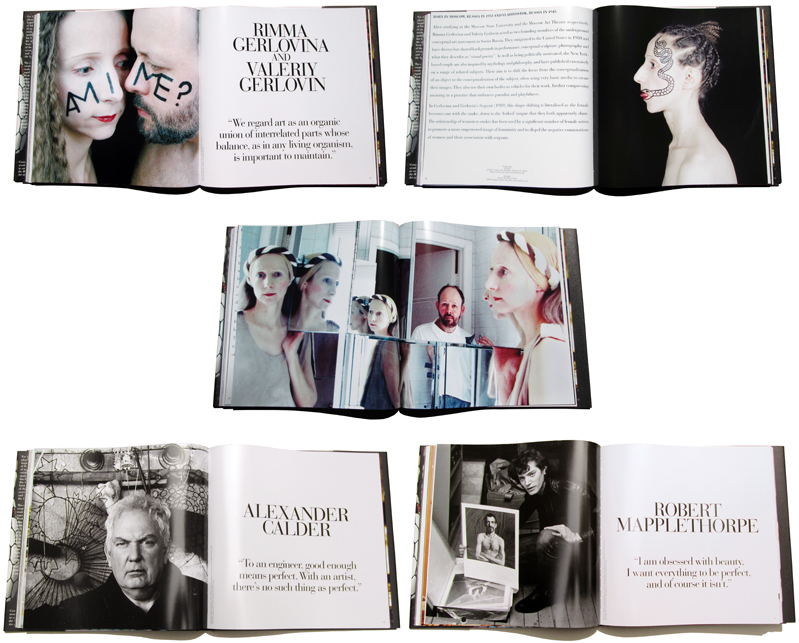
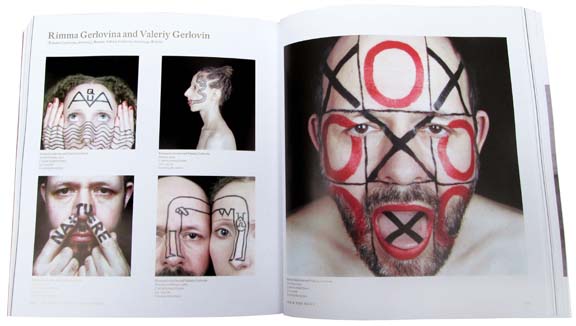
Rimma Gerlovina and Valeriy Gerlovin The Concepts, 2012, book published by The Library of Moscow Conceptualism of German Titov, p. 429, Russian language. More about the book and the video
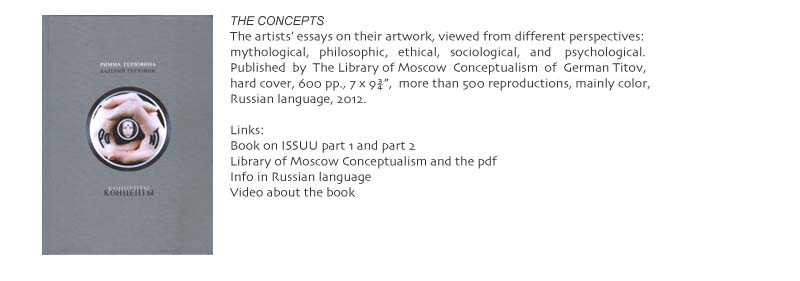


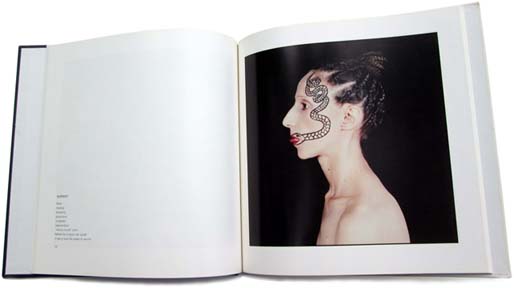
Book Art on the Edge and Over by Linda Weintraub, Arthur Danto, Thomas McEvilley, Art Insights, Inc., Publishers, 1996, pp.21, 236-241
"The Gerlovins produce "photoglyphs," a term they originated to describe their gorgeous color photographs of mind-bending non sequiturs written on the artists' bodies and faces... concoct multiple, contradictory, logic-defying situations. They mirror our time...
Theories advanced by such renown scientists as David Bohm conform that the illogical unification of dichotomies actually abounds in the universe...The Gerlovins, like Bohm, disturb the elemental assumptions that constitute Western world order...
"We view art only as a vehicle (sic) to obtain a spiritual experience that transcends the intellect." (the Gerlovins) In search of a means "to transcend the intellect," the artists revised an old, venerated Russian art tradition, religious icon painting. Their photoglyphs are vested in this legacy. Like the painted icon, they dematerialize the physical world and arrest time. Their subject is, most often, Rimma's porcelain face, which glows with the grace and enigmatic calm of a Madonna. Furthermore, the photoglyphs recapitulate the format of an icon. Rimma's figure is positioned centrally in the composition. She exists in a dark space devoid of references to the mundane world. Her "still performances," as she calls them, consist of poses, facial expressions, and gazes that speak of eternity. Rimma embodies the mysticism of the Russian icon. These works envision a nondimensional, nontemporal, nonphysical world." Linda Weintraub

Jacksonville Art Museum Booklet for the exhibition Photoglyphs, Jacksonville, Fl, June/July 1993
"Rimma"s face makes a wonderful canvas, recalling the enigmatic calm and monumental stasis of 16th-century Northern Renaissance Madonna. Her face lends itself beautifully to the Gerlovins' explorations with words and symbols. Rimma's serenity, the spare formality of her features, offer viewers the quiet essential of the ethical and intellectual values that concern this creative pair."
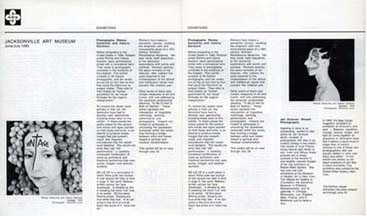
Amei Wallach, "GerlovinŐs "Decade of Freedom", Newsday, May 31, 1991
"In Moscow in Brezhnev's '70s, the husband-and-wife team of Rimma Gerlovina and Valeriy Gerlovin contributed a great many of the active ingredients that caused an underground art movement to flourish and spread... They organized an exhibition at Franklin Furnace, the Downtown art-book and performance space, of the books and documentations that constituted that constituted the "Russian samizdat art" of the artistic underground. And they evolved a definition of samizdat that permitted them to keep alive its spirit, even in Soho: "Samizdat art is not an institution, but a strategy."
The Fine Arts Museum of Long Island has done us the great favor of gathering together a retrospective of 104 of the Gerlovins' works from the past decade. It's a particular strong exhibition of work by artists who are long overdo for this type of scrutiny. And it's an object lesson in how an artist can make the mind-boggling transition from a totalitarian to a free-for-all culture with dignity, integrity and some damn good art.
For sheer artistry her 1983 "One Man Show" sculpture steals the part of the show. The man hangs from the ceiling, the cubbyholes have doors to open, and each reveals an absurd tableau, an exhortation, a little scene, some with uplifting and often contradictory messages, although on throws us off center with the note: "back in five minutes."
Valeriy Gerlovin relies on the purely visual to the same end in his "Head" series of disjointed faces constructed of plywood and syringes or nails in which the nose reads like a staircase, the dislocations come out of cubism, and the overall effect is of some billboard version of a Russian icon.
Starting in the mid of '80s, the Gerlovins began to collaborate on what they call "Photoglyphs." These are monumental C-prints, usually of Rimma, with words, symbols, numbers, paradoxes painted on her strikingly Botticelli face framed in Renaissance ringlets...
There's endless invention here, disciplined and consistent. The exhibition is an object lesson in how to survive the dislocations of history to make art that counts."
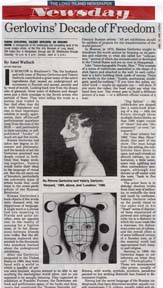
Links:
Colorado State University Museum collection
David McCracken, "Photoglyphs" Merge Verbal, Visual Powers", Chicago Tribune, April 26, 1991
Back to Photoreliefs part 3 > Photoreliefs part 4> Фотоглифы 1>
